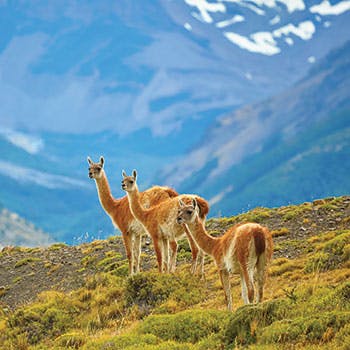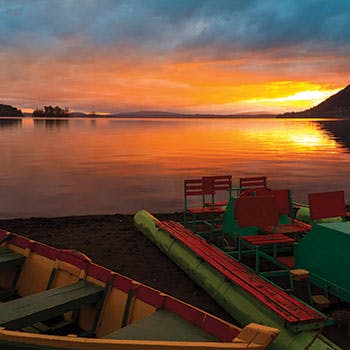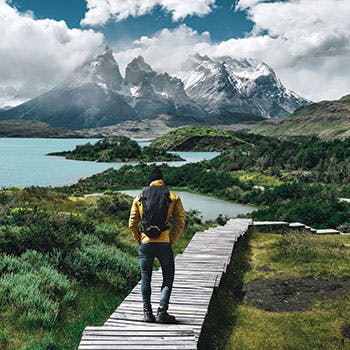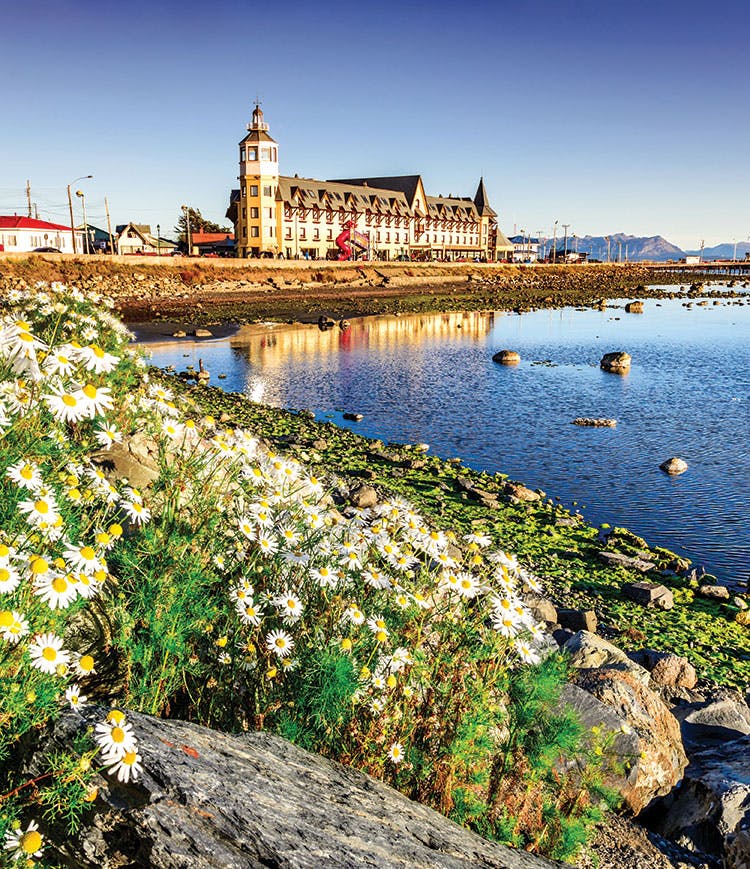If you’ve ever wanted to know what the edge of the world looks like, you’ll find it in Patagonia. Located at the southern tier of the Andes Mountains near the tip of Chile, Patagonia is where the Southern Hemisphere, Pacific Ocean, and the Strait of Magellan combine their powers to concoct unbelievable landscapes. In one day, you can kayak turquoise lakes, hike amongst wildflowers, cross roaring creeks and rivers, and sip a YOLO pisco sour served over glacier ice. Get a sneak peek of Patagonia’s boundless nature through these must-sees in and around Torres del Paine National Park.
The granite towers of Torres del Paine give this UNESCO biosphere and reserve its name stemming from torres (towers) and paine (indigenous word for blue). The park, a favorite amongst outdoor enthusiasts, has been compared to a mini Alaska with its shimmering azure lakes, cascading waterfalls, sprawling glaciers, and abundant wildlife.
PUERTO NATALES
The gateway to Torres del Paine National Park is a quaint town named Puerto Natales. Located on the Last Sound Hope, you can fuel up for your adventure in Torres de Paine at its many restaurants with the typical Chilean dishes of pastel de choclo (Chilean Sheperd’s Pie) or curanto (a hearty stew with shellfish, meat, and vegetables). Take a day-tour of the Patagonian fjords, gear up at various outdoor apparel and hiking supply stores, or just rest up for spellbinding hikes and a wealth of unforgettable sights for your upcoming days.
EN ROUTE TO TORRES DEL PAINE
From Puerto Natales to the national park is twenty-four kilometers, but the road winds amongst amazing scenery. Most recommend taking your time to witness the unexpected such as a guanaco crossing, lakeside photo stops, and a tour of Cueva del Milodón (Cave of the Grand Sloth).
LAKE PEHOE
The color in the name of the park can be seen in contrast to the pillars and the sky, but some of the most remarkable hues of blue in the park are from its lakes. The crown jewel of the lakes is Lake Pehoe. Its aquamarine color invites you for a swim, but don’t be fooled. The waters are mountain and glacier fed. The best way to witness these powerful colors and get to your next hike is via a motorized catamaran. The boat leaves Jetty Pudeto heading toward Refugio Paine Grande two to four times daily depending on weather and the season. Regardless of month, be prepared for a breathtaking, albeit windy and chilly ride.
TOWERS, W TREK, OR O CIRCUIT
If you’re staying long enough, you can enjoy the five-day W Trek, which encompasses hiking along various valleys and lakes with the finale of summiting the Tower base. If you are enjoying a short stay, you can do just the towers in a day from your accommodations or camp. For those intrepid travelers, the longest and most strenuous of the hikes is the O Circuit. This eight-day trek goes along the backside of the towers and includes the W Trek.
GREY LAKE AND GREY GLACIER
Grey Glacier lends another shade of otherworldly blue to the park, and the best way to see it up close and personal is via boat. It is a three-hour journey where you spend one-hour at the feet of Grey’s myriad of blues. With a height of thirty meters and an expansive length of six kilometers, Grey Glacier will forever etch glacier blue into your memory. For those who want to become one with the glacier and celebrate, the crew offers the national drink, pisco sour, which is made with lime juice, egg white, sugar, and pisco, served over glacier ice. On your way to the pier, as you enjoy your libation, keep your eyes peeled as icebergs pass the boat.
Capture blues that change your perspective of color forever in Patagonia. Taste a pisco sour with glacier ice in Torres del Paine. Relish the landscape from the summit of the Towers. Is it time to experience your version of Patagonia?
Travel Tips



When to Go
As Patagonia is in the Southern Hemisphere, the best time to travel is in the region’s summer months, which are December through February; however, fall (March through May) is shoulder season with fewer travelers.
How to Get There
Fly to Punta Arenas via Santiago with LATAM, Jetsmart, or Sky Airline. Then, take a three-hour scenic ride from Punta Arenas to Puerto Natales.
What to Pack
You can experience all four seasons in one day, so pack for wind, rain, and intense sunshine. Hiking boots, poles, a hat, and comfortable, layered clothing are must-brings.
How to Pay
The official currency of Chile is the Chilean Peso (CLP). At press time, $1 USD is equivalent to $683 CLP. It is wise to carry some local currency, which you can get via an ATM or by exchanging at the airport or local banks. Most outfitters in Puerto Natales will accept cards, but not all vendors along your adventure will accept credit or debit cards.



